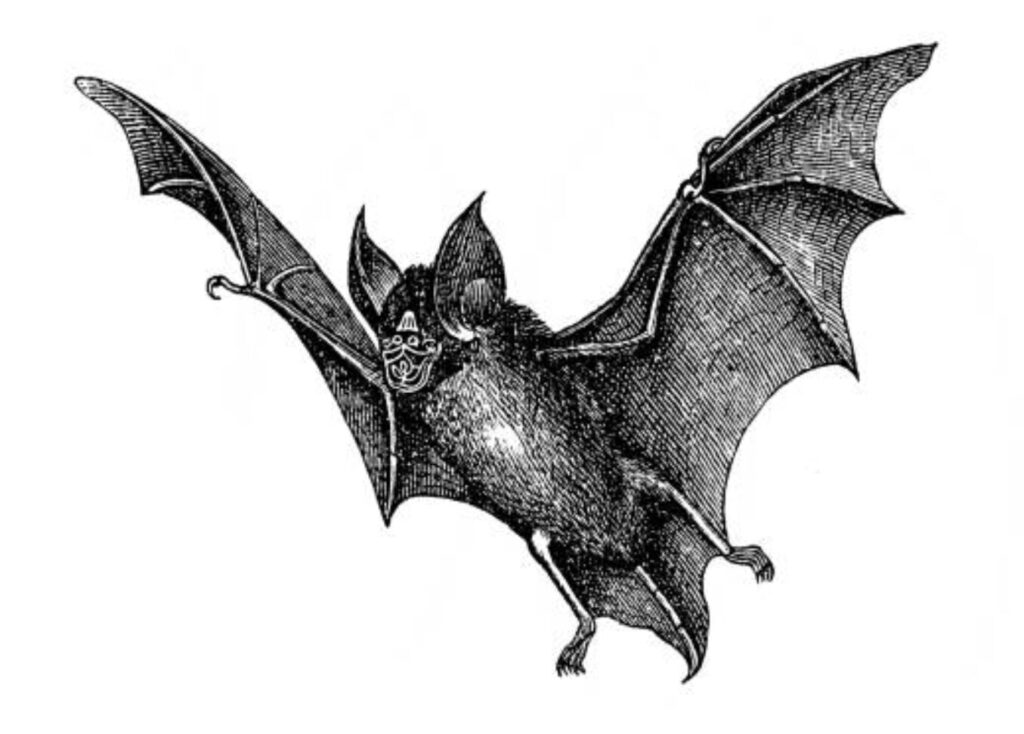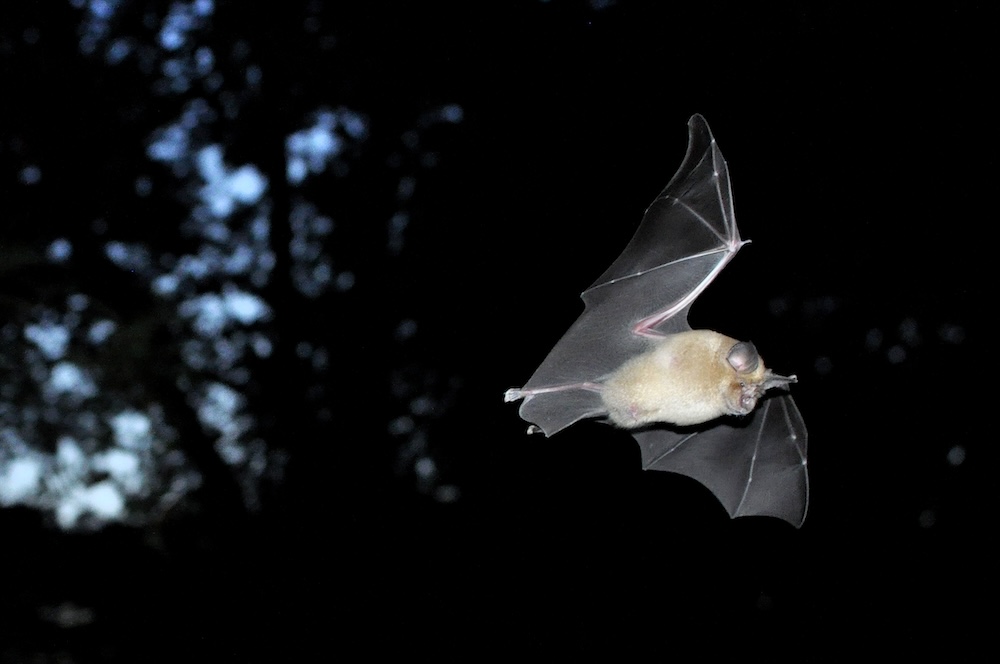Dan Richards introduces a chiropteran extract from his latest book ‘Overnight: Journeys, Conversations and Stories After Dark’ — a celebration of all things nocturnal.

In June 2023, I visited Devon to see bats of Buckfastleigh as research for a book that I was writing about the nocturnal world.
I was joined by Ava Osbiston, a local life-coach and artist whom I’ve known since my Norwich art-school days, and photographer Nicholas White.
Buckfastleigh is home to several thousand greater horseshoe bats, the largest maternity roost in Europe. Our guides that evening were Pam Barrett, former mayor of the town, and Phil Wilson, founder member of The June Brides.
Pam runs bat tours to introduce people to the gloaming peregrinations of Rhinolophus ferrumequinum – the largest of the horseshoe bats in Europe with a body 5–7cm long and a 35–40cm wingspan. The ‘horseshoe’ in question is the half-moon-shaped nose leaf which helps focus the ultrasound it uses to echolocate, giving its face the slightly truncated, unfinished aspect of an iced bun missing its glacé cherry.
The first greater horseshoe emerged shortly after dusk, passed overhead, making the bat detector sing like a euphoric R2-D2.
The sound it made was unlike any bats I’d heard before, a trailing cascade, fading in, fading out, the middle a swirl of theremin slightly off-station, an ARP synthesiser heard in free-fall.
Though the light in the sky was almost gone, a sodium street-lamp allowed a glimpse of fleet shapes massing in the woods around, gyring up to make the leap through the trees above our heads.
‘They’re having a bit of a swirl,’ said Pam, and then they suddenly deployed as black chutes, hurtling in bursts of five or six, the high mercury song of each spilling from our speakers.
The following extract from Overnight is from slightly later in the evening once we’d left the road where we first saw the bats and moved to a path beside the River Mardle.
 Image courtesy Pam Barrett/Phil Wilson
Image courtesy Pam Barrett/Phil Wilson
GREATER HORSESHOE BATS, BUCKFASTLEIGH, DEVON: JUNE 2023
We stand looking down a dark arcade of trees. As my night vision returns after the light of the road I start to see motion all around and realise I’m standing in the eye of a bat tornado. Where others might have flinched at the scud of bird-sized smuts apparently zeroing in on my face, I felt a pure delight.
Reassured by Pam’s assertion that there was enough space for both of us, that I wasn’t disconcerting the bats, I sought to focus on the shapes spinning silently through space, relishing this unexpectedly close encounter.
‘We can always tell when the babies are first coming out because they fly all over the place,’ Pam whispers. ‘In August this whole area gets filled with bats. It takes them about ten days to work out the route and then they’re set, regular as clockwork. This is my favourite place to see them.’
Ava and Nick join us, bringing their bat detector, which fills the tree tunnel with doppler-droid song.
‘Do you think this bothers them, hearing this?’ asks Ava.
I doubt they recognise it as themselves, I say, mind spiralling back to the question of what the world looks and sounds like to a bat.
I tune back in to Pam telling Ava and Nick how the greater horseshoe’s glitter-bomb song contains a multitude of messages – specific chat, general broadcasts, navigational sweeps, concentrated hunting flechettes, like laser beams. They’re likely not hunting at this point, mostly they’re focused on safe passage down to the Dart. ‘And don’t forget, they’re practically all females and they’ve got babies, so they’re really quite desperate to eat.’
Ava asks if they lactate.
Yes, confirms Pam. They’re mammals.
‘Bat milk!’ laughs Ava. In a night of delights this feels like an apex bat-fact.
What do they eat?
‘These bats like beetles so they’re not really interested in midges. They like quite big food, chunky beetles. And for a long time the population was in crisis and numbers plummeted, but they’ve since recovered and a big part of it has been projects working with farmers to try and persuade them to not routinely worm their cattle. Because cowpats that have been treated with wormer are infertile, so dung beetles can’t live in them and greater horseshoes love dung beetles. So there’s been work done by various wildlife projects to try and get farmers to just worm when they need to, rather than routinely. And that has apparently made a big difference. Midges aren’t enough for them.’
‘A midge is like a crumb to these bats,’ whispers Ava dreamily.
‘Not in the Cairngorms, they’re not!’ counters Nick. ‘Up there they’d be like basking sharks.’
Bats flown, count over, Phil appears at Pam’s elbow: ‘Six hundred and ten – not bad.’
‘Do you want to see the Daubentons?’ asks Pam, the bat sweet shop having not yet closed.
‘They do make a great noise,’ enthuses Phil. ‘A superb fart when they’re catching something. In flight they crackle like a machine gun, and then they home in on something and . . .’ He blows a delighted raspberry.
 Image courtesy Pam Barrett/Phil Wilson
Image courtesy Pam Barrett/Phil Wilson
* * * * *
The Buckfastleigh Daubentons like to fly figures of eight. Sometimes there are two, sometimes six or seven. Pam has never seen them arrive at the bridge where they hunt, skimming down to snaffle insects, almost touching the water before scooting up to the arch and back again . . . They’re quite hard to see.
She tells us they’re little, maybe slightly bigger than a pipistrelle. ‘Chunkier, certainly . . . but I’m sorry they’re not here. They’re always here.’
We stand near the bridge looking into the water. To pass the time, Pam gives us gen on the town. ‘Buckfastleigh had the highest proportion of social housing in all of England for a while – obviously, per head – because this is a wool and foundry town, a medieval tanning centre, old industry. So the river was full of arsenic and everything used in the tanning process. Our house is Georgian, part of the new town. At the top of the hill, you’ve got the medieval town, and in the heart of that we’ve the last surviving sheepskin-tanning factory in Britain. They do all the skins for Rolls-Royce, Saudi jets, that sort of thing. And we’ve got a uranium mine in Buckfastleigh,’ she enthuses. ‘It’s just up this river. Unfenced and lethal. It’s where Marie Curie’s pitchblende came from. About ten feet inside the adit you’ve higher radiation background than Fukushima.’
The silence around us feels slightly deeper now, probably because the Daubentons are listening too.
‘And this is the Hound of the Baskervilles place,’ Pam continues. ‘The evil lord of the manor, Brook Manor, which is Elizabethan or earlier than that, he’s buried up on that hill.’
‘Surrounded by lead!’ adds Phil. Causing half the party to jump. ‘Yes, and iron so that he can’t get out.’
‘So his evil spirit can’t get out,’ nods Phil, ‘but a black dog came out the night Conan Doyle was brought here and told the story by Mr Baskerville, his local chauffeur.’
To be fair, I say, seeking to lighten the mood a little, he might have just been buried in lead because the area’s famously rich in uranium.
‘And we took our town council over,’ resumes Pam, unbowed. ‘I was mayor here for five years or something stupid. And I run the swimming pool here, the oldest pool in Devon – it’s about 125 years old.’
Well, that’s nice, I think. Good to know Buckfastleigh isn’t all arsenic, uranium and phosphoric gothic.
‘And there’s the County Lines. This park is a fairly big spot for drug dealing, because you can come in off the A38, whizz round, drop off there and the police can’t catch you. Oh yes, you get a lot of nefarious goings-on here.’
A flicker on the bat detector.
‘That’s a Daubenton! I didn’t see it but it’s here.’
Another muffled crackle. A kind of geiger-counter clicking, a rat-a-tat-tat.
‘That’s the sort of noise I thought the bats were going to make,’ says Ava, ‘not the songs we’ve had this evening.’
We all peer at the rippling water, a patch of street-light shimmer where, suddenly, two small bats are turning circles. They weren’t there a second ago but, as Pam foretold, they’ve magically appeared. And now, as abruptly, a clear icy sound snaps from the detector, not a crackle this time but something manic, metallic and skittering akin to Aphex Twin’s ‘Bucephalus Bouncing Ball’. How could such a loud sound emanate from such a small fluffy creature? It was as if everything we’d just heard about Buckfastleigh was blasting from the bat: the industry, the gothic horror, the fast drugs . . . A concentrated nuclear blast.
‘They all came out for you tonight,’ smiles Pam as we take our leave.
‘What a brilliant night,’ enthuses Nick as we drive home.
He wants to return to Buckfastleigh with ultraviolet film – the thought of snapping Greater Horseshoes in flight filling him with joy.
‘What a great night,’ he repeats to himself. ‘What an amazing thing.’
*
‘Overnight: Journeys, Conversations and Stories After Dark’ is out now and available here, published by Canongate.